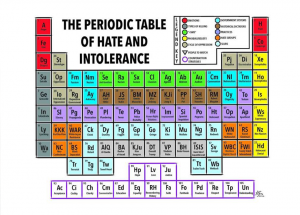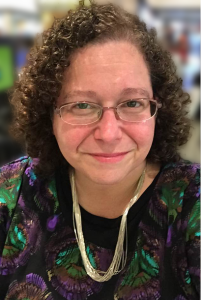In the Age of COVID-19, Diane R. Wiener Comments on Amy Cohen Efron’s The Periodic Table of Hate and Intolerance.


Trigger Warnings (TW)
In this blog, I will use content or “trigger” warnings. “Triggers” are representations of subjects that have the potential to cause emotional pain or distress; triggers can also manifest or change, over time. TW: slurs, profanity, hate messages, and strong language.
April 15, 2020
In her brave and controversial work, The Periodic Table of Hate and Intolerance, Amy Cohen Efron does what in Yiddishkeit (Eastern European-inflected Jewish culture) might be called a “chutzphadik” move: she takes up taboos, disturbing language, and hurtful imagery and turns them toward the reader/viewer. In doing so, Cohen Efron insists that people (as artistic consumers, receivers, and creators) consider the fraught, dangerous, and often deadly interconnections that exist necessarily between slurs, disenfranchisement, oppression, social violence, and—vitally—history and other legacies.
The interdependence of -isms and -obias cannot be noted exhaustively in one piece of art. Any absences may be interpreted by some as commentary, however unintended on the part of any given artist. In Cohen Efron’s Periodic Table, a notable absence is Transphobia, for example; while I conjecture that Cohen Efron meant no harm in this omission, it is affecting. Nevertheless, her effort to underscore social justice as the basis for refuting fascism is undeniable and vivid.
The work contains no content warnings, but has a key or legend, as might a map. While other Periodic Tables have catalogued themes as wide ranging as desserts, peppers, and emotions, this particular redux of the famous chemistry chart makes strategic usage of political premises to disrupt, augment, and forward others. Cohen Efron’s use of the N-word is arguably beyond what is feasible, given her own identities; the assertion can be made, indeed, that only “insiders” ought to be able to adopt, adapt, or use certain “insider” language, at all, for critical, reclaimed, or any other well-intended purposes. However, the overall presentation remains one of compassion and solidarity.
This message of compassion and solidarity could not be more important than it is, right now, as I write these words “under lockdown,” in the middle of the COVID-19 pandemic. The idea that this pandemic is a “great equalizer” is wholly unfounded, given the disproportional devastation this virus and its myriad strains have wrought among and upon Communities of Color, including folx living in indigenous cultural contexts and on tribal lands known as reservations, because their nascent land was stolen by white “settlers.”
In this moment, and always, as Cohen Efron’s artwork asserts, we must work in collaborative ways to undermine marginalization, pain, and harm, in all of their forms.
About the Commentator: Diane R. Wiener, MSW, PhD, is a professor, disability rights advocate and activist, poet/writer, editor, singer, bassist, artist, and social worker. Visit her online at: https://dianerwiener.com/

Artist’s Statement of Amy Cohen Efron (Owner of AEfron Arts and Culture Website)
My art is about my Deaf experience, focusing on how I view society; how society views me; and the relationship between society and me. All my art works are visually striking, explosive, subliminal, and abstract. I do not limit myself to one medium, style, or concept. My work is a constant search for the best way to interpret the absurdity, resistance, and celebration I’ve experienced every day. I try addressing controversial themes and raising thought-provoking questions through art. I believe advertising imagery, with hidden messages, bold colors, strong lines, and using symbolism, serve as significant influences in my art.
It is my goal for creating art as an agent for social change. If a viewer stops for just a moment to view, think, and reflect on artwork I have created, then I have succeeded.


0 comments on “In the Age of COVID-19, by Diane R. Wiener”